NotablePublications
Journals
May-June 2019
Volume 11 | Issue 3
Page Nos. 97-142
Online since Wednesday, June 12, 2019
Accessed 2,679 times.
PDF access policy
Full text access is free in HTML pages; however the journal allows PDF access only to users from INDIA and paid subscribers.
EPub access policy
Full text in EPub is free except for the current issue. Access to the latest issue is reserved only for the paid subscribers.
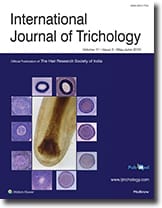
Skin Appendage Disorders
The first journal exclusively dedicated to research and treatment of hair, nail and skin gland diseases
Aims and Scope
Skin Appendage Disorders provides a wide range of original and review articles dealing with all aspects of hair, nail and skin glands. The section ‘Novel Insights from Clinical Practice’ introduces special case examples and their treatments. Innovative therapies are presented under the heading ‘Novel Treatments’, and in ‘Clinical Investigations’ the latest findings are discussed. A special highlight are the articles in the section ‘Guidelines’ that present the consensus treatments, and which are a must-read for everyone who wants to stay up-to-date. The section ‘Adnexal Surgery‘ focuses on both established and approved as well as new surgical treatments. Pathological evaluation of skin appendage disorders requires specific training and the ‘Pathology’ section will be open to original papers and reviews on this topic.
Covering all aspects of the field, Skin Appendage Disorders is of primary importance for dermatologists in clinics and research, dermatological surgeons as well as cosmetic dermatologists.
Bibliographic Details
Skin Appendage Disorders
Journal Abbreviation: Skin Appendage Disord
ISSN: 2296-9195 (Print)
e-ISSN: 2296-9160 (Online)
DOI: 10.1159/issn.2296-9160
www.karger.com/SAD
Indexing/Abstracting
Listed in bibliographic services, including:
PubMed | US National Library of Medicine
PubMed Central | US National Library of Medicine
Emerging Sources Citation Index | Clarivate Analytics
Google Scholar | Google
WorldCat | OCLC
Scopus | Elsevier
History
Founded in 2015 by Antonella Tosti and Dimitris Rigopoulos
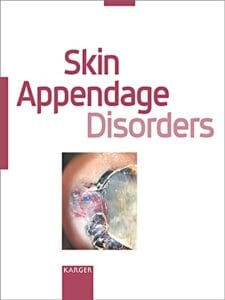
Textbooks
Dermoscopy of the Hair and Nails, 2nd Edition
Edited by: Antonella Tosti, MD
Summary
When the first edition of this pioneering text was published, only a few dermatologists were trained to utilize the dermatoscope for the diagnosis and follow-up of hair diseases. The technique is now more popular worldwide, prompting the development of this updated second edition, which now includes a section devoted entirely to nail dermoscopy and also covers many hair disorders that were not previously discussed.
Topics covered include alopecias, hair shaft disorders, hair root evaluation, pediatric hair disorders, hair weathering, inflammatory scalp disorders, infections, dermoscopy of the black scalp, body hair disorders, and dermoscopy-guided biopsies.
Also covered is dermoscopy of the nail plate, the proximal nail fold, the hyponychium, and the distal edge of the nail plate. The book discusses inflammatory nail disorders, traumatic nail disorders, onychomycosis, melanonychia, and nail tumors. This essential new edition facilitates diagnosis of hair disorders and provides clinicians with important clues about disease stage and progression.
-Summary and image from CRC Press
https://www.crcpress.com/Dermoscopy-of-the-Hair-and-Nails/Tosti/p/book/9781482234053
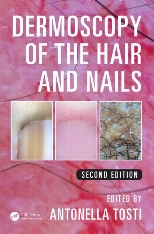
Hair and Scalp Disorders: Medical, Surgical, and Cosmetic Treatments, Second Edition
Edited by: Amy J. McMichael, MD; Maria K. Hordinsky, MD
Summary
A succinct and comprehensive guide examining the treatment of hair and scalp disorders, with a special emphasis on how hair type, morphology, and ethnicity can impact on hair disease and treatment. This updated and revised second edition builds on a successful first edition with additional chapters on dermoscopy, on how technology can best be integrated into clinical practice, and on aging hair.
-Summary and image from CRC Press
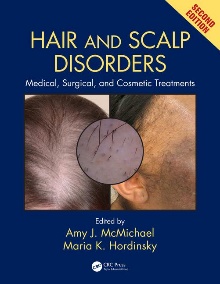
An Atlas of Hair Pathology with Clinical Correlations 2nd Edition
Leonard C Sperling, Shawn E. Cowper, Eleanor A. Knopp
Summary
Diagnosing and treating hair disorders is still a subject that is rarely or only superficially covered in residency training. Hence, dermatopathologists and clinical dermatologists often find a gap in their knowledge. A new edition of an acclaimed text, An Atlas of Hair Pathology with Clinical Correlations, Second Editionbridges this gap and serves as a primer, an atlas, and a reference.
Features:
- Supplies basic information on anatomy
- Examines clinical features that provide a clinical / pathological correlation
- Details the practical processes of evaluating specimens
- Includes new photographs demonstrating basic and advanced histologic features of hair disease
- Explores several new diagnoses
Disorders in this edition include senescent balding, loose anagen hair syndrome, psoriatic alopecia, and psoriatic alopecia, and chemotherapy-induced alopecia. The book also contains a glossary of terms related to hair pathology.
-Summary and image from CRC Press

Hair Loss: Principles of Diagnosis and Management Alopecia
by Jerry Shapiro, MD of Univ. of British Columbia, Vancouver, Canada.
Summary
Blends clinical detail with the latest research and theories of pathogenesis. Complex issues are presented with photographs and photomicrographs included.
https://www.amazon.com/Hair-Loss-Principles-Diagnosis-Management/dp/1853178764
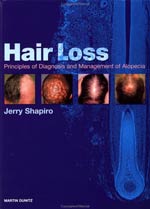
Hair Loss and Restoration 2nd Edition
Jerry Shapiro, Nina Otberg
Summary
Treatment of hair disorders has progressed considerably over time. More patients are now interested in hair care and some are bombarded by promising advertisements. In reality, hair disorders may be complex and require accurate diagnosis for suitable treatment.
Hair Loss and Restoration provides an extensive look at the practical management, both medical and surgical, of all forms of hair loss. Proper examination of the patient with hair loss is discussed in depth as is androgenetic alopecia, the most common cause of hair loss. The autoimmune disease alopecia areata is examined comprehensively, including its pathogenesis, clinical features, differential diagnosis, and treatment. This edition also covers new developments on the diagnosis and treatment of the disease.
Hair loss from drugs and radiation is reviewed along with other topics such as telogen effluvium and frontal fibrosing alopecia—an increasing concern in scarring hair loss. Hair restoration surgery is described in detail and an excellent review of what is available from a nonmedical approach to hair loss is provided. Extensively referenced and illustrated with more than 300 clinical color photographs, this compact and easy-to-read book is a valuable resource for both doctors and patients.
-Summary and image from CRC Press
https://www.crcpress.com/Hair-Loss-and-Restoration/Shapiro-Otberg/p/book/9781482231977
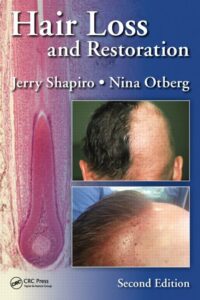
Disorders of Hair Growth
Elise A. Olsen, MD
Summary
A comprehensive book on the subject of hair loss! Highly illustrated, with 250 new color photographs, this resource covers the basic science, diagnosis, and treatment of all problems related to hair. Conditions covered include childhood hair loss, excessive body hair, various types of adult balding, and loss due to medical conditions, trauma, and medications. The new Second Edition emphasizes various new diagnosis and treatment methods including popular, recently approved remedies.
https://www.amazon.com/Disorders-Hair-Growth-Elise-Olsen/dp/0071364943

Journal Articles
Dhouailly D. A new scenario for the evolutionary origin of hair, feather, and avian scales. J Anat. 2009 Apr;214(4):587-606.
Lehman JM, Laag E, Michaud EJ, Yoder BK. An essential role for dermal primary cilia in hair follicle morphogenesis. J Invest Dermatol. 2009 Feb;129(2):438-48. Epub 2008 Nov 6.
Jaks V, Barker N, Kasper M, van Es JH, Snippert HJ, Clevers H, Toftgård R. Lgr5 marks cycling, yet long-lived, hair follicle stem cells. Nat Genet. 2008 Nov;40(11):1291-9. Epub 2008 Oct 12.
Kloepper JE, Tiede S, Brinckmann J, Reinhardt DP, Meyer W, Faessler R, Paus R. Immunophenotyping of the human bulge region: the quest to define useful in situ markers for human epithelial hair follicle stem cells and their niche. Exp Dermatol. 2008 Jul;17(7):592-609.
Yi R, Poy MN, Stoffel M, Fuchs E. A skin microRNA promotes differentiation by repressing 'stemness'. Nature. 2008 Mar 13;452(7184):225-9. Epub 2008 Mar 2.
Fuchs E. Making the paper. Nature. 2008 Mar 13;452(7184):xii.
Wang S, Lin X, Wan Y, et al. Maternal PPAR gamma protects nursing neonates by suppressing the production of inflammatory milk. Genes Dev. 2007 Aug 1;21(15):1895-908. Epub 2007 Jul 24.
Cotsarelis G, Ito. Making the paper. 2007 May 17;447(7142):xiii
Ito M, Yang, Z, Andl T, Cui C, Kim, N, Millar SE, Cotsarelis G. Wnt-dependent de novo hair follicle regeneration in adult mouse skin after wounding. Nature 2007 May 17;447(7142):316-321
Deckelbaum RA, Majithia A, Booker T, Henderson JE, Loomis CA. The homeoprotein engrailed 1 has pleiotropic functions in calvarial intramembranous bone formation and remodeling. Development. 2006 Jan;133(1):63-74.
Yue Z, Jiang TX, Widelitz RB, Chuong CM. Wnt3a gradient converts radial to bilateral feather symmetry via topological arrangement of epithelia. Proc Natl Acad Sci U S A. 2006 Jan 24;103(4):951-5.
Oro AE. Mammalian variations on a theme: a Smo and Sufu surprise. Dev Cell. 2006 Feb;10(2):156-8.
Huntzicker EG, Estay IS, Zhen H, Lokteva LA, Jackson PK, Oro AE. Dual degradation signals control Gli protein stability and tumor formation.Genes Dev. 2006 Feb 1;20(3):276-81.
Perez-Moreno M, Davis MA, Wong E, Pasolli HA, Reynolds AB, Fuchs E. p120-catenin mediates inflammatory responses in the skin. Cell. 2006 Feb 10;124(3):631-44.
Bazzi H, Getz A, Mahoney MG, Ishida-Yamamoto A, Langbein L, Wahl JK 3rd, Christiano AM. Desmoglein 4 is expressed in highly differentiated keratinocytes and trichocytes in human epidermis and hair follicle. Differentiation. 2006 Mar;74(2-3):129-40.
Morgan BA. Upending the hair follicle. Nat Genet. 2006 Mar;38(3):273-4.
Schmidt-Ullrich R, Tobin DJ, Lenhard D, Schneider P, Paus R, Scheidereit C. NF-kappaB transmits Eda A1/EdaR signalling to activate Shh and cyclin D1 expression, and controls post-initiation hair placode down growth. Development. 2006 Mar;133(6):1045-57.
Stenn KS, Cotsarelis G, Price VH. Report from the cicatricial alopecia colloquium. J Invest Dermatol. 2006 Mar;126(3):539-41.
Yi R, O'Carroll D, Pasolli HA, Zhang Z, Dietrich FS, Tarakhovsky A, Fuchs E. Morphogenesis in skin is governed by discrete sets of differentially expressed microRNAs. Nat Genet. 2006 Mar;38(3):356-62.
Barrick D, Kopan R. The Notch transcription activation complex makes its move. Cell. 2006 Mar 10;124(5):883-5.
Takeda H, Lyle S, Lazar AJ, Zouboulis CC, Smyth I, Watt FM. Human sebaceous tumors harbor inactivating mutations in LEF1. Nat Med. 2006 Apr;12(4):395-7.
Kauser S, Slominski A, Wei ET, Tobin DJ. Modulation of the human hair follicle pigmentary unit by corticotropin-releasing hormone and urocortin peptides. FASEB J. 2006 May;20(7):882-95.
Trivedi NR, Gilliland KL, Zhao W, Liu W, Thiboutot DM. Gene array expression profiling in acne lesions reveals marked upregulation of genes involved in inflammation and matrix remodeling. J Invest Dermatol. 2006 May;126(5):1071-9.
Wu P, Jiang TX, Shen JY, Widelitz RB, Chuong CM. Morphoregulation of avian beaks: comparative mapping of growth zone activities and morphological evolution. Dev Dyn. 2006 May;235(5):1400-12.
Andl T, Murchison EP, Liu F, Zhang Y, Yunta-Gonzalez M, Tobias JW, Andl CD, Seykora JT, Hannon GJ, Millar SE. The miRNA-processing enzyme dicer is essential for the morphogenesis and maintenance of hair follicles. Curr Biol. 2006 May 23;16(10):1041-9.
Rhee H, Polak L, Fuchs E. Lhx2 maintains stem cell character in hair follicles. Science. 2006 Jun 30;312(5782):1946-9.
Cotsarelis G. Epithelial stem cells: a folliculocentric view. J Invest Dermatol. 2006 Jul;126(7):1459-68.
Potter CS, Peterson RL, Barth JL, Pruett ND, Jacobs DF, Kern M, Argraves WS, Sundberg JP, Awgulewitsch A. Evidence that the satin hair mutant gene Foxq1 is among multiple and functionally diverse regulatory targets for Hoxc13 during hair follicle differentiation. J Biol Chem. 2006 Jul 10;
Nijhof JG, Braun KM, Giangreco A, van Pelt C, Kawamoto H, Boyd RL, Willemze R, Mullenders LH, Watt FM, de Gruijl FR, van Ewijk W. The cell-surface marker MTS24 identifies a novel population of follicular keratinocytes with characteristics of progenitor cells.Development. 2006 Aug;133(15):3027-37.
NTong X and Coulomb PA: Keratin 17 modulates hair follicle cycling in a TNF alpha-dependent fashion. Genes Development 20:1353-1364, 2006.
Blanpain C, Fuchs E. Epidermal Stem Cells of the Skin. Annu Rev Cell Dev Biol. 2005
Jamora C, Lee P, Kocieniewski P, Azhar M, Hosokawa R, Chai Y, Fuchs E. A signaling pathway involving TGF-beta2 and snail in hair follicle morphogenesis. PLoS Biol. 2005 Jan;3(1):e11. Epub 2004 Dec 28.
Sano S, Chan KS, Carbajal S, Clifford J, Peavey M, Kiguchi K, Itami S, Nickoloff BJ, DiGiovanni J. Stat3 links activated keratinocytes and immunocytes required for development of psoriasis in a novel transgenic mouse model. Nat Med. 2005 Jan;11(1):43-9.
Sharov AA, Fessing M, Atoyan R, Sharova TY, Haskell-Luevano C, Weiner L,Funa K, Brissette JL, Gilchrest BA, Botchkarev VA. Bone morphogenetic protein (BMP) signaling controls hair pigmentation by means of cross-talk with the melanocortin receptor-1 pathway. Proc Natl Acad Sci U S A. 2005 Jan 4;102(1):93-8.
Gonzalez-Quevedo R, Shoffer M, Horng L, Oro AE. Receptor tyrosine phosphatase-dependent cytoskeletal remodeling by the hedgehog-responsive gene MIM/BEG4. J Cell Biol. 2005 Jan 31;168(3):453-63.
Pearton DJ, Yang Y, Dhouailly D. Transdifferentiation of corneal epithelium into epidermis occurs by means of a multistep process triggered by dermal developmental signals.Proc Natl Acad Sci U S A. 2005 Mar 8;102(10):3714-9.
Wun BP, Tao Q, Lyle S. Autofluorescence in the stem cell region of the hair follicle bulge. J Invest Dermatol. 2005 Apr;124(4):860-2.
Devgan V, Mammucari C, Millar SE, Brisken C, Dotto GP. p21WAF1/Cip1 is a negative transcriptional regulator of Wnt4 expression downstream of Notch1 activation. Genes Dev. 2005 Jun 15;19(12):1485-95.
Silva-Vargas V, Lo Celso C, Giangreco A, Ofstad T, Prowse DM, Braun KM, Watt FM. Beta-catenin and Hedgehog signal strength can specify number and location of hair follicles in adult epidermis without recruitment of bulge stem cells. Dev Cell. 2005 Jul;9(1):121-31.
Sano S, Chan KS, Kira M, Kataoka K, Takagi S, Tarutani M, Itami S, Kiguchi K, Yokoi M, Sugasawa K, Mori T, Hanaoka F, Takeda J, DiGiovanni J. Signal transducer and activator of transcription 3 is a key regulator of keratinocyte survival and proliferation following UV irradiation. Cancer Res. 2005 Jul 1;65(13):5720-9.
Shu W, Guttentag S, Wang Z, Andl T, Ballard P, Lu MM, Piccolo S, Birchmeier W, Whitsett JA, Millar SE, Morrisey EE. Wnt/beta-catenin signaling acts upstream of N-myc, BMP4, and FGF signaling to regulate proximal-distal patterning in the lung. Dev Biol. 2005 Jul 1;283(1):226-39
Mecklenburg L, Tobin DJ, Cirlan MV, Craciun C, Paus R. Premature termination of hair follicle morphogenesis and accelerated hair follicle cycling in Iasi congenital atrichia (fzica) mice points to fuzzy as a key element of hair cycle control. Exp Dermatol. 2005 Aug;14(8):561-70.
Vauclair S, Nicolas M, Barrandon Y, Radtke F. Notch1 is essential for postnatal hair follicle development and homeostasis. Dev Biol. 2005 Aug 1;284(1):184-93
Benitah SA, Frye M, Glogauer M, Watt FM. Stem cell depletion through epidermal deletion of Rac1. Science. 2005 Aug 5;309(5736):933-5.
Vidal VP, Chaboissier MC, Lutzkendorf S, Cotsarelis G, Mill P, Hui CC, Ortonne N, Ortonne JP, Schedl A. Sox9 is essential for outer root sheath differentiation and the formation of the hair stem cell compartment. Curr Biol. 2005 Aug 9;15(15):1340-51
Alonso L, Okada H, Pasolli HA, Wakeham A, You-Ten AI, Mak TW, Fuchs E. Sgk3 links growth factor signaling to maintenance of progenitor cells in the hair follicle. J Cell Biol. 2005 Aug 15;170(4):559-70.
Sarin KY, Cheung P, Gilison D, Lee E, Tennen RI, Wang E, Artandi MK, Oro AE, Artandi SE. Conditional telomerase induction causes proliferation of hair follicle stem cells. Nature. 2005 Aug 18;436(7053):1048-52.
Lechler T, Fuchs E. Asymmetric cell divisions promote stratification and differentiation of mammalian skin. Nature. 2005 Sep 8;437(7056):275-80.
Wong TH, Rees JL. The relation between melanocortin 1 receptor (MC1R) variation and the generation of phenotypic diversity in the cutaneous response to ultraviolet radiation. Peptides. 2005 Oct;26(10):1965-71.
Claudinot S, Nicolas M, Oshima H, Rochat A, Barrandon Y. Long-term renewal of hair follicles from clonogenic multipotent stem cells. Proc Natl Acad Sci U S A. 2005 Oct 11;102(41):14677-82. Epub 2005 Oct 3.
Rendl M, Lewis L, Fuchs E. Molecular dissection of mesenchymal-epithelial interactions in the hair follicle. PLoS Biol. 2005 Nov;3(11):e331. Epub 2005 Sep 20.
Itami S, Inui S. Role of androgen in mesenchymal epithelial interactions in human hair follicle. J Investig Dermatol Symp Proc. 2005 Dec;10(3):209-11.
Ito M, Liu Y, Yang Z, Nguyen J, Liang F, Morris RJ, Cotsarelis G. Stem cells in the hair follicle bulge contribute to wound repair but not to homeostasis of the epidermis. Nat Med. 2005 Dec;11(12):1351-4.
Levy V, Lindon C, Harfe BD, Morgan BA. Distinct stem cell populations regenerate the follicle and interfollicular epidermis. Dev Cell. 2005 Dec;9(6):855-61.
Roh C, Tao Q, Photopoulos C, Lyle S. In vitro differences between keratinocyte stem cells and transit-amplifying cells of the human hair follicle. J Invest Dermatol. 2005 Dec;125(6):1099-105.
Tobin DJ, Hordinsky M, Bernard BA. Hair pigmentation: a research update. J Investig Dermatol Symp Proc. 2005 Dec;10(3):275-9
Yue Z, Jiang TX, Widelitz RB, Chuong CM. Mapping stem cell activities in the feather follicle. Nature. 2005 Dec 15;438(7070):1026-9
Pearton DJ, Ferraris C, Dhouailly D. Transdifferentiation of corneal epithelium: evidence for a linkage between the segregation of epidermal stem cells and the induction of hair follicles during embryogenesis. Int J Dev Biol. 2004;48(2-3):197-201
Djabali K, Zlotogorski A, Metzker A, Ben-Amitai D, Christiano AM. Interaction of hairless and thyroid hormone receptor is not involved in the pathogenesis of atrichia with papular lesions. Exp Dermatol. 2004 Apr;13(4):251-6.
Engelhard A, Christiano AM. The hairless promoter is differentially regulated by thyroid hormone in keratinocytes and neuroblastoma cells. Exp Dermatol. 2004 Apr;13(4):257-64.
Lo Celso C, Prowse DM, Watt FM. Transient activation of beta-catenin signalling in adult mouse epidermis is sufficient to induce new hair follicles but continuous activation is required to maintain hair follicle tumours. Development. 2004 Apr;131(8):1787-99.
Morris RJ, Liu Y, Marles L, Yang Z, Trempus C, Li S, Lin JS, Sawicki JA,Cotsarelis G. Capturing and profiling adult hair follicle stem cells. Nat Biotechnol. 2004 Apr;22(4):411-7.
Andl T, Ahn K, Kairo A, Chu EY, Wine-Lee L, Reddy ST, Croft NJ, Cebra-Thomas JA, Metzger D, Chambon P, Lyons KM, Mishina Y, Seykora JT, Crenshaw EB 3rd,Millar SE. Epithelial Bmpr1a regulates differentiation and proliferation in postnatal hair follicles and is essential for tooth development. mDevelopment. 2004 May;131(10):2257-68.
Jahoda CA, Kljuic A, O'Shaughnessy R, Crossley N, Whitehouse CJ, Robinson M, Reynolds AJ, Demarchez M, Porter RM, Shapiro L, Christiano AM. The lanceolate hair rat phenotype results from a missense mutation in a calcium coordinating site of the desmoglein 4 gene. Genomics. 2004 May;83(5):747-56
Chang CH, Yu M, Wu P, Jiang TX, Yu HS, Widelitz RB, Chuong CM. Sculpting skin appendages out of epidermal layers via temporally and spatially regulated apoptotic events. J Invest Dermatol. 2004 Jun;122(6):1348-55.
Thiboutot D. Regulation of human sebaceous glands. J Invest Dermatol. 2004 Jul;123(1):1-12.
Reddy ST, Andl T, Lu MM, Morrisey EE, Millar SE. Expression of Frizzled genes in developing and postnatal hair follicles. J Invest Dermatol. 2004 Aug;123(2):275-82.
Blanpain C, Lowry WE, Geoghegan A, Polak L, Fuchs E. Self-renewal, multipotency, and the existence of two cell populations within an epithelial stem cell niche. Cell. 2004 Sep 3;118(5):635-48.
Brennan D, Hu Y, Kljuic A, Choi Y, Joubeh S, Bashkin M, Wahl J, Fertala A,Pulkkinen L, Uitto J, Christiano AM, Panteleyev A, Mahoney MG. Differential structural properties and expression patterns suggest functional significance for multiple mouse desmoglein 1 isoforms.Differentiation. 2004 Oct;72(8):434-49.
Roh C, Tao Q, Lyle S. Dermal papilla-induced hair differentiation of adult epithelial stem cells from human skin. Physiol Genomics. 2004 Oct 4;19(2):207-17.
Hanakawa Y, Li H, Lin C, Stanley JR, Cotsarelis G. Desmogleins 1 and 3 in the companion layer anchor mouse anagen hair to the follicle. J Invest Dermatol. 2004 Nov;123(5):817-22.
Pan Y, Lin MH, Tian X, Cheng HT, Gridley T, Shen J, Kopan R. gamma-secretase functions through Notch signaling to maintain skin appendages but is not required for their patterning or initial morphogenesis. Dev Cell. 2004 Nov;7(5):731-43.
Brancaccio A, Minichiello A, Grachtchouk M, Antonini D, Sheng H, Parlato R, Dathan N, Dlugosz AA, Missero C. Requirement of the forkhead gene Foxe1, a target of sonic hedgehog signaling,in hair follicle morphogenesis. Mol Genet. 2004 Nov 1;13(21):2595-606.
Ito M, Kizawa K, Hamada K, Cotsarelis G. Hair follicle stem cells in the lower bulge form the secondary germ, a biochemically distinct but functionally equivalent progenitor cell population, at the termination of catagen. Differentiation. 2004 Dec;72(9-10):548-57.
Kim H, Panteleyev AA, Jahoda CA, Ishii Y, Christiano AM. Genomic organization and analysis of the hairless gene in four hypotrichotic rat strains. Mamm Genome. 2004 Dec;15(12):975-81.
Mayer JA, Chuong CM, Widelitz R. Rooster feathering, androgenic alopecia, and hormone-dependent tumor growth: what is in common? Differentiation. 2004 Dec;72(9-10):474-88.
Mill P, Mo R, Fu H, Grachtchouk M, Kim PC, Dlugosz AA, Hui CC. Sonic hedgehog-dependent activation of Gli2 is essential for embryonic hair follicle development. Genes Dev. 2003 Jan 15;17(2):282-94.
Van Mater D, Kolligs FT, Dlugosz AA, Fearon ER. Transient activation of beta -catenin signaling in cutaneous keratinocytes is sufficient to trigger the active growth phase of the hair cycle in mice. Genes Dev. 2003 May 15;17(10):1219-24
Panteleyev AA, Mitchell PJ, Paus R, Christiano AM. Expression patterns of the transcription factor AP-2alpha during hair follicle morphogenesis and cycling. J Invest Dermatol. 2003 Jul;121(1):13-9.
Xu X, Lyle S, Liu Y, Solky B, Cotsarelis G. Differential expression of cyclin D1 in the human hair follicle. Am J Pathol. 2003 Sep;163(3):969-78.
Zhang M, Brancaccio A, Weiner L, Missero C, Brissette JL. Ectodysplasin regulates pattern formation in the mammalian hair coat. Genesis. 2003 Sep;37(1):30-7.
Niemann C, Unden AB, Lyle S, Zouboulis ChC, Toftgard R, Watt FM. Indian hedgehog and beta-catenin signaling: role in the sebaceous lineage of normal and neoplastic mammalian epidermis. Proc Natl Acad Sci U S A. 2003 Sep 30;100 Suppl 1:11873-80.
Kantor J, Kessler LJ, Brooks DG, Cotsarelis G. Decreased serum ferritin is associated with alopecia in women. J Invest Dermatol. 2003 Nov;121(5):985-8.
Liu Y, Lyle S, Yang Z, Cotsarelis G. Keratin 15 promoter targets putative epithelial stem cells in the hair follicle bulge. J Invest Dermatol. 2003 Nov;121(5):963-8.
Allen M, Grachtchouk M, Sheng H, Grachtchouk V, Wang A, Wei L, Liu J, Ramirez A, Metzger D, Chambon P, Jorcano J, Dlugosz AA. Hedgehog signaling regulates sebaceous gland development. Am J Pathol. 2003 Dec;163(6):2173-8.
McElwee KJ, Kissling S, Wenzel E, Huth A, Hoffmann R. Cultured peribulbar dermal sheath cells can induce hair follicle development and contribute to the dermal sheath and dermal papilla. J Invest Dermatol. 2003 Dec;121(6):1267-75.
Nishimura EK, Jordan SA, Oshima H, Yoshida H, Osawa M, Moriyama M, Jackson IJ, Barrandon Y, Miyachi Y, Nishikawa S. Dominant role of the niche in melanocyte stem-cell fate determination. Nature. 2002 Apr 25;416(6883):854-60.
Andl T, Reddy ST, Gaddapara T, Millar SE. WNT signals are required for the initiation of hair follicle development. Dev Cell. 2002 May;2(5):643-53.
Loomis CA. Development and morphogenesis of the skin. Adv Dermatol. 2001;17:183-210.
Oshima H, Rochat A, Kedzia C, Kobayashi K, Barrandon Y. Morphogenesis and renewal of hair follicles from adult multipotent stem cells. Cell. 2001 Jan 26;104(2):233-45.
Ellis T, Gambardella L, Horcher M, Tschanz S, Capol J, Bertram P, Jochum W, Barrandon Y, Busslinger M. The transcriptional repressor CDP (Cutl1) is essential for epithelial cell differentiation of the lung and the hair follicle. Genes Dev. 2001 Sep 1;15(17):2307-19.
Panteleyev AA, Jahoda CA, Christiano AM. Hair follicle predetermination. J Cell Sci. 2001 Oct;114(Pt 19):3419-31.
Holbrook KA, Minami SI. Hair follicle embryogenesis in the human. Characterization of events in vivo and in vitro. Ann N Y Acad Sci. 1991 Dec 26;642:167-96.
